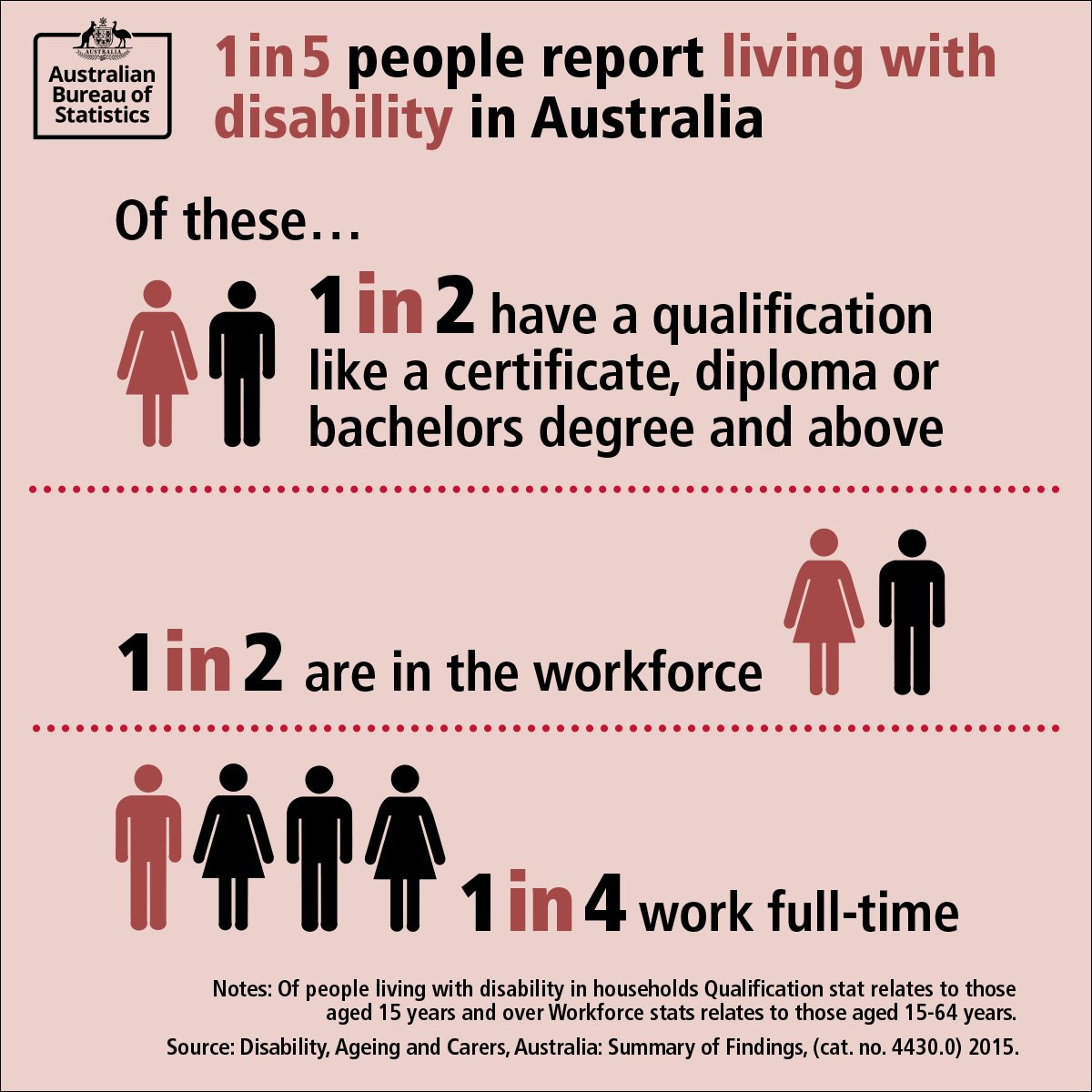Talking to employees about a disability or health condition
Talking about disability in the workplace can be a daunting task, for both employees and managers.
Perceived discrimination, privacy, legal concerns and lack of knowledge of how to do it, can deter businesses from approaching the subject of disability and illness with staff.

Why talk about it?
-
support your current and future staff to stay healthy, happy and productive
-
retain talented, valuable staff
-
attract top candidates
-
avoid possible discrimination complaints
-
market your business as an inclusive leader, attracting like-minded customers

Simple steps before you ask
Create an environment that celebrates diversity and inclusion.
Make it comfortable and easy for employees to come forward with issues around their health and wellbeing, knowing that they will be treated appropriately and with minimal fuss.
This can involve:
-
establishing processes and systems for employees to approach management
-
proactively implementing workplace adjustments such as ramps and accessible toilets
-
proactively offering flexible work practices, such as working from home
-
promoting relevant internal and external resources, such as diversity and inclusion policies, and your Employee Assistance Scheme provider
-
celebrate the achievements of staff with disabilities
%20%E2%80%A2%20Instagram%20photos%20and%20videos.png?width=995&name=Screenshot_2021-02-09%20Castle%20(%20castlepersonnel)%20%E2%80%A2%20Instagram%20photos%20and%20videos.png)
Educate managers about disability
Build your own, and your managers' confidence to address employee's concerns about their health and wellbeing. With employees more likely to approach a coworker or manager than HR, it is crucial that managers are equipped with the knowledge and skills to support staff with disability and health issues.
Training and resources for managers can include;
-
Australian Disability Network's Access and Inclusion Index
-
NSW Government's Disability Inclusion Manager Toolkit
Be open and honest about what you are asking
Whether you are monitoring your business's diversity and inclusion progress, or hoping to encourage employees to ask for assistance, it is important to assuage any fears of discrimination or other, that will prevent employees from sharing.
Communicating your purpose openly and showcase the benefits that responses can have, such as an increase representation of disabilities amongst staff that was not previously known.
A message from the management addressing your goals, reasoning, assurances of privacy, and ongoing strategy, can build trust and encourage more honest respondents.
 Report the results back to your workforce, the steps you are undertaking as a result, and the timeframe for implementing them.
Report the results back to your workforce, the steps you are undertaking as a result, and the timeframe for implementing them. 
When, and What to Ask
Although some employees and applicants will be proactive with sharing personal health information, especially those with more 'visible' disabilities, it can be safe to assume many won't.
Knowing when, what and how to approach the subject can make a huge difference in helping employees feel comfortable and confident to respond openly. Some of the following examples can also simply create an opportunity where an employee can come forward.

When
Recruitment Process
-
Advertising a role should state that people with disabilities are encouraged to apply.
-
Each applicant should be asked if they need adjustments to participate in the recruitment process, such as phone interviews or flexible timing
Medical or Physical Assessment
-
Psychological or physical tests given to all applicants should be directly related to the role, such as lifting or maths aptitude.
Job Offer
-
In a letter of offer, ask if the employee requires any adjustments made to the workplace or role, even if they haven't disclosed the need prior.
Induction
-
As part of employee inductions, ask all new staff if they require any adjustments, again, even if they haven't disclosed requirements earlier.
Performance Appraisal
-
Remind staff during performance appraisals that adjustments can be made to accommodate health conditions and disabilities, without impacting career progression.
Staff Survey
-
Include questions about disability and health conditions in regular staff surveys. Be clear whether responses are anonymous or not.
 It is important to assuage any fears of discrimination by ensuring that every applicant and employee is given the opportunity to disclose a disability or health condition, not just the people you think need help. When asked at a number of stages from recruitment right through to promotion, employees have a chance to disclose a disability they might not have felt comfortable doing initially.
It is important to assuage any fears of discrimination by ensuring that every applicant and employee is given the opportunity to disclose a disability or health condition, not just the people you think need help. When asked at a number of stages from recruitment right through to promotion, employees have a chance to disclose a disability they might not have felt comfortable doing initially.
What to ask, and what not to ask
Depending on the individual circumstances, there are several ways to approach the topic of disability with staff and candidates.
Remembering that the vast majority of illnesses and disabilities are invisible (up to 90%), it is important that you treat everybody equally, creating an environment where they feel comfortable sharing personal information.
-
Before and during an interview
Focus on the employee's ability to do the job and particular tasks, not their disability. Legally, it is entirely up to the candidate to disclose an illness, injury or disability.What not to ask
"do you have a disability/medical condition?"
"do you have any past injuries/workcover claims?"
"will you need lots of extra time off?"What you can ask instead
"do you need any adjustments to the interview/recruitment process?"
"how can we provide additional support to you in the workplace?"
"is there anything preventing you from doing specific tasks safely? -
Inductions and on-boarding assessments
Again, focus on the specifics of the job, rather than disability in general.What not to say
"what does your disability/condition stop you from doing?"
"declare now if you have a disability or health condition"What you can ask instead
"reasonable adjustments are provided to staff with health conditions, we invite you to let us know how we can support you in the workplace"
"Do you have any injuries that impact your ability to lift heavy objects?"
"Do you have ideas for making your job easier/safer?" -
Engagement Survey
Incorporate questions about disability into your regular staff engagement surveys to allow you to monitor trends in your workforce. Disability and health issues are constantly changing in the workplace, so it is important to maintain regular communication.
Tips
Making the responses anonymous can encourage greater engagement and ask more direct questions. Give the respondents the option to 'prefer not to answer', and remind them of who to contact if they require support for a disability or illness.What you can ask
"Do you have a disability?" Yes | No | Prefer not to say
"If Yes, do you require adjustments to your working arrangements?" Yes | No | Prefer not to say
"What reasons do you have if you have not requested adjustments to your working arrangements?"
- Does not impact on my work
- Concerned I may be treated differently
- Concern it may disadvantage me now or in the future
- OtherAvoid asking
The type, name, and cause of disability or health condition. These are irrelevant to their capacity to work and can lead to unhelpful labelling.
Language such as 'declare' or 'disclose' can suggest they have something to hide. -
Non-anonymous surveys can provide more information to track progress over time, such as participation in training, career progression, and retention; and the proportion of staff with disability in different business units or divisions.
Obligations
Reasonable Adjustments
For practical advice on 'reasonable adjustment' processes, contact the experienced team at Castle. 
Legal
A business must comply with the Disability Discrimination Act 1992, Fair Work Act 2009, and relevant privacy responsibilities.
Find out more